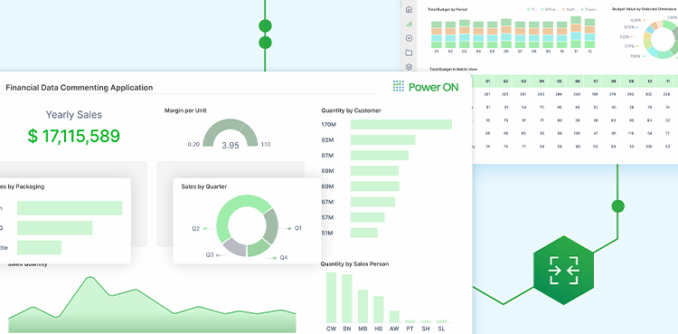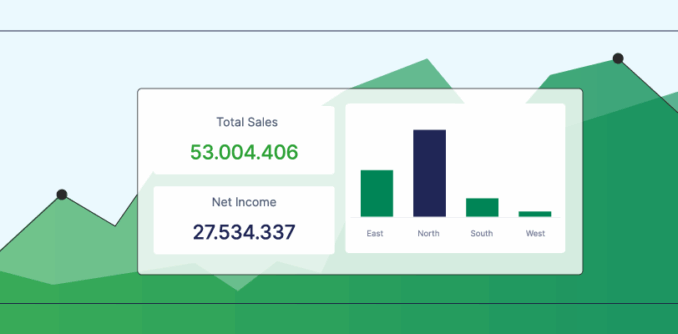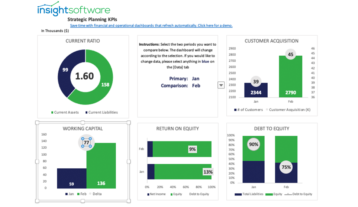Strategic Workforce Planning Best Practices for 2025

In many parts of the world, labor markets are under stress. Companies are struggling to find employees with the right mix of skills and to apply those skills effectively and efficiently. As a result, strategic workforce planning is garnering considerable attention today, and workforce planning software is in high demand.
Workforce planning means analyzing a company’s existing staffing levels, then anticipating and planning for future needs. It impacts recruitment and hiring, employee promotion, retention and turnover policies, and learning and development programs. Workforce planning is ultimately about fulfilling the company’s strategic goals, addressing its needs at a tactical level, and increasing productivity.
Drive Your Business Into the Fast Lane With Collaborative Budgeting and Planning
Access ResourceLike any other planning process, strategic workforce planning has both short-term and long-term implications. A short-term goal might be to onboard enough workers to increase production in the coming quarter, for example, so that the company can fulfill orders during a seasonal peak.
Longer-term trends, such as a new wave of generational requirements, should also be on the radar for strategically-minded human resources managers. Large companies that operate mainframe computers, for example, are currently facing a rapidly diminishing pool of skilled COBOL programmers.
Strategic workforce planning encompasses the entire picture, everything to do with human resources within the company. Having said that, it is necessarily a collaborative function. In other words, HR managers must work closely with other business units to ensure that plans meet the needs of all stakeholders.
What is Workforce Planning?
Workforce Planning is a strategic process that aligns an organization’s staffing needs with its long-term business goals. By forecasting future workforce requirements, analyzing current staffing levels, and identifying skill gaps, Workforce Planning ensures that an organization has the right number of people with the right skills at the right time. This process involves assessing both short-term and long-term labor needs and creating action plans to fill those requirements effectively, allowing businesses to be agile, proactive, and prepared for growth or change.
Why Workforce Planning is Important
Workforce Planning is critical for maintaining operational efficiency and driving strategic growth. By proactively managing staffing needs, organizations can reduce the risks associated with talent shortages, high turnover, and skill gaps. Effective Workforce Planning allows businesses to prepare for upcoming challenges, such as new projects or expansions, and to avoid the costly consequences of understaffing or hiring misalignment. Additionally, with a well-planned workforce, companies can improve employee satisfaction by aligning roles with skills, resulting in better retention and a stronger, more resilient workforce.
How Workforce Planning Works
Workforce Planning involves several key steps, beginning with identifying business goals and assessing current workforce capabilities. Organizations then analyze future staffing needs based on projected growth, industry trends, and technological advancements. Using this data, they create a roadmap to bridge gaps, whether through hiring, training, or workforce restructuring. Workforce Planning tools and software aid in tracking employee data, forecasting needs, and modeling potential scenarios, making it easier to adjust staffing strategies in real time. Regular reviews are essential, allowing organizations to stay aligned with changing demands.
Key Components of Workforce Planning
Effective Workforce Planning relies on several critical components, each contributing to a comprehensive strategy for aligning staffing needs with organizational goals. By focusing on the following elements, organizations can anticipate future demands, bridge skill gaps, and maintain a well-prepared workforce that supports both short-term productivity and long-term growth. These components allow leaders to approach workforce planning methodically, reducing the risk of talent shortages, costly turnover, and misaligned hiring. Here are the essential components that drive successful Workforce Planning:
- Forecasting and Analysis: Anticipating future workforce needs by analyzing business objectives, market trends, and technological shifts. This foresight helps ensure long-term alignment between the workforce and evolving organizational goals.
- Skill Gap Assessment: Evaluating the skills and competencies within the current workforce to identify areas that could impact future performance. Understanding these gaps allows organizations to plan for targeted training, recruitment, or role adjustments.
- Recruitment and Retention Strategies: Developing strategies to attract and retain top talent, with an emphasis on reducing turnover and improving engagement. Focusing on recruitment and retention strengthens organizational stability and supports team morale.
- Succession Planning: Preparing for critical role transitions by identifying high-potential employees who can step into leadership roles when needed. Succession planning ensures continuity in leadership and preserves organizational knowledge.
- Budget and Resource Allocation: Allocating resources effectively to support workforce requirements, including hiring, training, and compensation. Proper budgeting helps optimize spending, ensuring that the workforce strategy is financially sustainable.
Examples of Workforce Planning
Examples of Workforce Planning include preparing for seasonal hiring spikes, planning for workforce reduction or expansion based on economic forecasts, and creating succession plans for key leadership roles. Workforce Planning enables companies to proactively address these scenarios, ensuring they are well-prepared to handle staffing needs efficiently.
- Seasonal Hiring: Retail and customer service industries often require more staff during holiday seasons. Workforce Planning allows businesses to recruit and train temporary employees ahead of these peaks.
- Economic Adjustments: Companies may plan for workforce expansion or reduction in response to economic conditions, adapting headcount based on revenue forecasts and market demands.
- Succession Planning: Organizations anticipating retirements in leadership roles can use Workforce Planning to prepare internal candidates through training and development programs.
Key Challenges of Workforce Planning
Implementing Workforce Planning presents several challenges, such as accurately predicting future workforce needs, managing budget constraints, and adapting to unforeseen changes. Accurate forecasting demands reliable data and a deep understanding of industry trends, which can be complex and resource-intensive. Budget constraints also play a critical role, as limited resources can restrict a company’s ability to hire or retain the necessary talent.
- Accurate Forecasting: Predicting future workforce needs requires high-quality data and insights into market trends, often demanding advanced analytics.
- Budget Constraints: Financial limitations may hinder a company’s ability to fully staff or retain talent, impacting the quality of Workforce Planning.
- Unforeseen Disruptions: Unexpected events, such as economic downturns or changes in industry demand, may require rapid adjustments to workforce plans, highlighting the need for flexibility and adaptability.
Addressing these challenges helps organizations build resilient workforce plans that can withstand economic shifts and support long-term growth.
9 Best practices for Workforce Planning
Best practices focus on aligning staffing needs with business goals and market conditions. Regular workforce assessments help adapt to changes, while data-driven forecasting improves projection accuracy. Prioritizing skill development ensures employees are prepared for future roles, and succession planning creates a pipeline of talent for leadership transitions. Regularly reviewing and adjusting plans keeps Workforce Planning responsive to economic shifts and industry trends, building a resilient team prepared for future challenges.
Here are some best practices for strategic workforce planning in 2025:
1. Understand the Organization’s Strategic Goals
The entire workforce planning process should flow from the company’s strategic objectives. That means looking ahead to a far horizon and understanding what the organization’s needs will look like in three to five years. If the company intends to expand, for example, the plan should cultivate up-and-coming talent to fill management roles as the business grows. You’ll want people who have experience in the company to step up and lead during the years ahead.
2. Understand the Organization’s Tactical Goals
Workforce planning is also about the short and medium term. If the company needs to ramp up capacity over the coming year to meet additional demand, HR should work with production and fulfillment to understand the specific skill sets required, timelines, and onboarding scenarios.
3. Assess Your Current Workforce
Finance and Human Resources must work together to understand staffing requirements, including the number of people required vs. how many are currently on staff and projected employee turnover. This analysis will need to include a breakdown of employees by skill set (including any specialized training or certifications required), to be mapped against expected capacity requirements and projected productivity levels. Analysts need to understand both the hard costs and soft costs associated with hiring and training new employees.
4. Determine Your Need for Elasticity
In many industries, like construction and hospitality, companies must be capable of scaling up or down quickly. This may be the result of fairly predictable seasonal changes, uncertainty with respect to future sales volumes, or potential disruptions that could impact the business. To plan with accuracy, analysts must understand their business’s natural ebb and flow of workforce requirements and keep an ear to the ground for impending disruptions.
A strategic workforce plan should include the use of contractors or outsourced services to accommodate the need for greater elasticity.
5. Identify Future Skills Needed
Working with leaders throughout the organization, HR should identify the skill sets required to support the business as its needs change. Planned projects or technology initiatives, product launches, or geographical expansion, for example, will dictate the particular skills and experience required to fulfill those plans successfully.
This list of requirements should be matched against an inventory of existing skills in the company’s workforce, resulting in a list of projected gaps and a roadmap for future recruitment.
6. Consider Alternative Scenarios
In many cases, a company’s executive management may be entertaining two or more potential future scenarios, such as a geographical expansion versus serving a new segment of customers within the company’s existing geographical footprint. The strategic workforce plan should allow for analysis of these different scenarios covering all potential outcomes on management’s radar.
Scenario analysis can also be useful in developing contingency plans in the context of an uncertain business environment. Following the initial onset of the global pandemic, for example, business leaders across virtually every industry turned to scenario modeling and planning to gain deeper insight into what the future might hold and how they might respond most effectively to rapidly changing conditions.
7. Define Your KPIs
As the strategic workforce planning process unfolds, participants should consider which quantifiable data points will be most meaningful in defining the success of the program. In other words, it’s important to establish metrics that will indicate whether or not the plan is on track to succeed. More than ever, successful organizations are relying on real-time metrics for insights into what’s working, what’s not, and how they might improve outcomes.
8. Monitor and Adjust
Planning processes are critically important, but change is inevitable. As the company moves forward, human resources professionals must be prepared to adapt and change as tactical and strategic priorities shift. It follows that planning tools must allow for ongoing input and collaboration with stakeholders across the organization, with the flexibility to modify targets to fit the organization’s changing requirements.
9. Equip Yourself With the Right Tools
Finally, it’s important to have the right tools in place to make the entire process work smoothly. Human resources has some special requirements with respect to the privacy and security of confidential employee data. Company executives need HR analytics that give them a complete picture, including employer taxes, benefits, and other non-wage expenses. They need anytime/anywhere access to critical information about compensation and employee performance, for example, to help them identify trends and achieve the company’s goals. Yet the security and confidentiality of that information is paramount. Having the right analytical tools in place, with collaboration features and adequate security, is critical.
With insightsoftware’s planning, reporting, and analytics solutions, you can align workforce planning with broader company objectives, collaborate with key leaders throughout your organization, and get real-time data and insights to the right people securely. You can recruit smarter by streamlining your processes and maximizing your total return on recruitment investment. To learn more, contact us today for a free, no-obligation demo.








